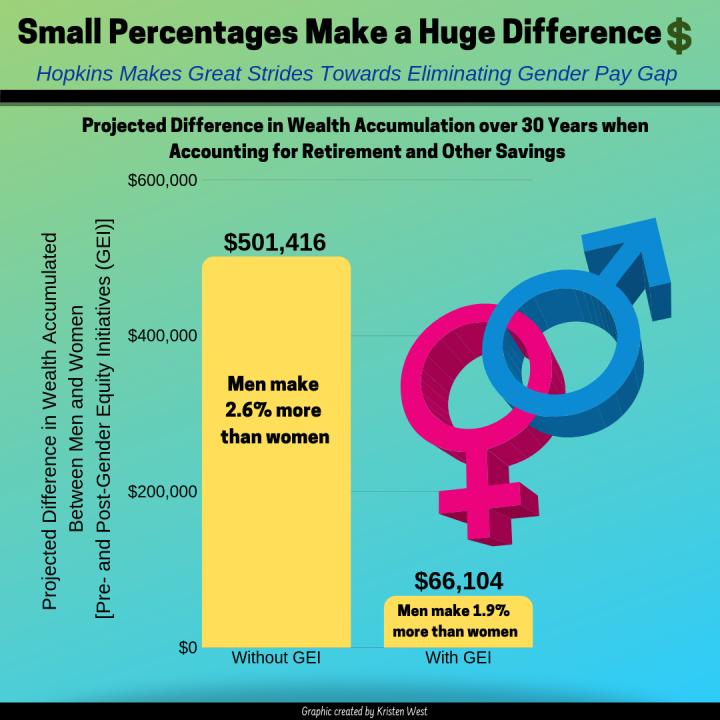When women medical school faculty make a few percent less per year than men, that means many tens of thousands of dollars less in lifetime wealth

Credit: Johns Hopkins Medicine, Kristen West
Around the country, women physician researchers make 7 to 8 percent less per year than men. At the Johns Hopkins University School of Medicine, efforts to eliminate such a gender disparity have cut the difference in salaries from 2.6 percent in 2005 to a statistically insignificant 1.9 percent in 2016. But even with that improvement and seemingly small pay gap, women faculty are likely to accumulate much less wealth over their lifetimes, Johns Hopkins researchers found.
The researchers used new models of wealth accumulation–taking into consideration how much faculty make, time between promotions, and the effects of salary on retirement and other savings–to calculate the numbers, which were published in JAMA Network Open on Dec. 21.
“One-and-a-half or 2 percent doesn’t sound so bad to most people, but at the end of the day, we’ve shown that this is really a lot of money,” says Barbara Fivush, M.D., professor of pediatrics at Johns Hopkins Children’s Center and senior associate dean of women in science and medicine at the Johns Hopkins University School of Medicine.
In 2002, after a report suggested the school of medicine was lagging in the promotion of women to professorship positions, the institution created a committee to pursue new ways to promote gender equity among faculty. Beginning in 2006, this committee’s recommendations–including annual salary analyses, recruitment of women faculty, interviews with departing women faculty and expanded sexual harassment education–were implemented.
“Johns Hopkins has done a great job of looking at, reporting and working to eliminate salary inequities over the last decade,” says Fivush. “But what we wanted to know was what those numbers at different time points really mean at the end of the day.”
Fivush and her colleagues analyzed the school of medicine’s internally published annual data on salary–which includes deidentified information on mean salary for faculty each year, categorized by gender, rank (assistant professor, associate professor or professor), and degree (those with a medical degree versus those without a medical degree). Data was available for 1,481 faculty (31 percent women) in 2005 and 1,885 faculty (39 percent women) in 2016.
The researchers designed simulations to calculate a person’s accumulated wealth by taking into consideration whether and when they would be promoted and how much money they could be investing for retirement at any given time. The simulations assumed an annual 3 percent raise for cost of living, pretax employer retirement contributions of 12 percent, maximum employee retirement contributions of $18,000 per year (with additional contributions after age 50, as federal regulations permit), a marginal tax rate of 33.3 percent, and investment returns of 7 percent for equity markets and 3 percent for bonds.
The researchers then calculated lifetime wealth accumulation under three different scenarios. A woman hired in 2005, they showed, would have accumulated $501,416 less in eventual salary and investment returns than a man hired at the same time if gender equity initiatives had not narrowed the pay gap from 2.6 to 1.9 percent. In a more real-time, fluid scenario, a woman hired in 2005 whose pay and promotions were positively affected by the initiative from 2006 through 2016 would go on to accumulate $210,829 less than a man in that position. And finally, a woman hired in 2016, with the 1.9 percent pay gap, is projected to accumulate $66,104 less.
“What’s important to take away from this is that the impact of even a small gap is still seen 30 years later, suggesting that interventions to address such inequities should not be delayed,” says Sara Alcorn, M.D., M.P.H., assistant professor of radiation oncology and molecular radiation sciences at the Johns Hopkins Kimmel Cancer Center and a senior author of the new paper.
The researchers admit that the simulations are just that–simulations with several standard assumptions. Any individual person may follow a different career path in terms of promotions or make different individual decisions on retirement savings. The salary gaps are likely larger in some medical subspecialties, Alcorn says, but data parsed by specialty is not available. In addition, pay gaps–and differences in retirement savings due to educational debt–likely exist in racial minority groups.
“Johns Hopkins has been working very hard to eliminate existing pay gaps and we have made great strides in this area, but more work is needed to continuously ensure pay is fair for all of our faculty,” says Janice Clements, Ph.D., vice dean for faculty at the Johns Hopkins University School of Medicine.
The team has made their simulation approach available to other institutions to do the same kinds of analyses, underscoring the long-term effect of salary disparities.
“We hope that other institutions put similar mechanisms in place to review salary and make calls for equity,” says Avani Rao, M.D., a radiation oncology resident and co-first author of the new paper along with Sarah Nicholas, M.D., also a radiation oncology resident at Johns Hopkins.
###
Other authors on the paper include Bartlomiej Kachniarz, Chen Hu, Kristin Redmond, Curtiland Deville, Jean Wright, Brandi Page, Stephanie Terezakis, Akila Viswanathan and Theodore DeWeese, all of the Johns Hopkins University School of Medicine.
The work was not directly supported by any grants. Hu separately received grants from the National Cancer Institute and personal fees from Merck and Varian Medical Systems; DeWeese reported grants, unrelated to the work, from the National Institutes of Health, Commonwealth Foundation and Digital Harmonic; Alcorn received a grant from the National Institutes of Health.
Media Contact
Marin Hedin
[email protected]
410-502-9429
Original Source
https:/




